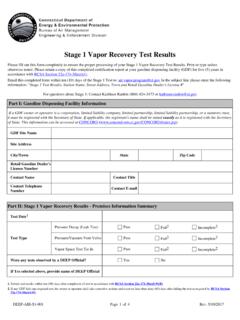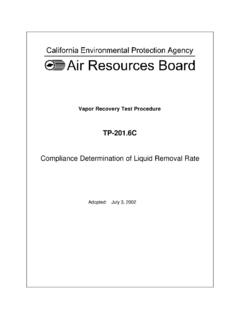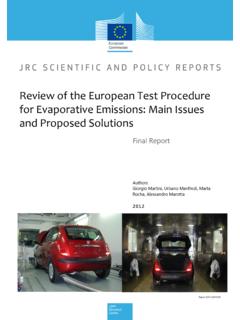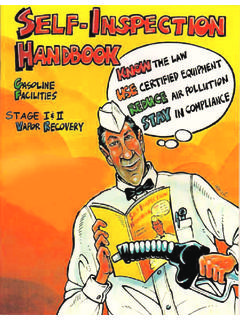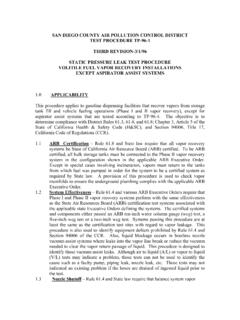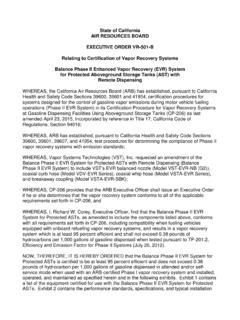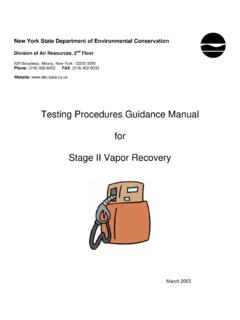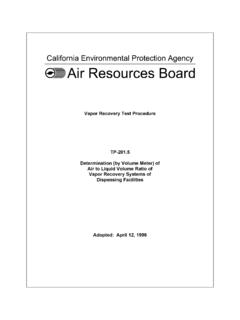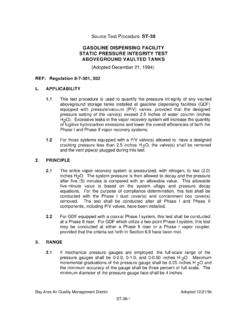Transcription of Executive Order VR-202-U Assist Phase II EVR System ...
1 Executive Order VR-202-U Assist Phase II EVR System Including In-Station Diagnostic (ISD) Systems Exhibit 9 VEEDER-ROOT ISD OPERABILITY TEST PROCEDURE The following procedures shall be used at field sites to determine the operability of the Veeder-Root ISD System to satisfy the requirements documented in vapor recovery CERTIFICATION PROCEDURE, CP-201, CERTIFICATION PROCEDURE FOR vapor recovery SYSTEMS AT GASOLINE DISPENSING FACILITIES. Testing the ISD equipment in accordance with this procedure will verify the equipment s operability for vapor Containment Monitoring and vapor Collection Monitoring.
2 Veeder-Root s TLS console ISD System Self-Test Monitoring algorithms are designed to verify proper selection, setup and operation of the TLS console modules and sensors and will not complete and report passing test results in the event of a failure of components used in the System . Completed ISD monitoring tests are evidence that: The System was properly powered for data collection All necessary ISD sensors were setup and connected All necessary ISD sensors were operating within specification All internal components including TLS console modules were properly setup and operating within specification Veeder-Root recommends printing a copy of the ISD ALARM STATUS and ISD DAILY report (REF.)
3 Section 5, Operation of the ISD Install, Setup & Operation Manual) periodically to determine that compliance tests are being completed in accordance with local and state regulations. A step-by-step worksheet for recording data from the following operability tests is provided at the end of this Exhibit. Note that districts may require use of an alternate form to meet these requirements, provided the alternate form includes the same minimum parameters. VR-202-U -2- Exhibit 9 Veeder Root ISD Operability Testing Definitions common to all certification and test procedures are in: D-200 Definition for vapor recovery procedures For the purpose of this procedure, the term ARB refers to the California Air Resources Board, and the term, ARB Executive Officer refers to the Executive Officer of the ARB or his or her authorized representative or designee.
4 vapor Pressure Sensor Verification Test 1. Purpose and Applicability The purpose of this test procedure is to determine if the Veeder-Root vapor Pressure Sensor (listed in Exhibit 1) is operating in accordance with the pressure sensor requirements of Exhibit 2. This procedure is used: To determine the measured ullage pressure in underground gasoline storage tanks (UST) installed at gasoline dispensing facilities (GDFs) equipped with a Assist Phase II enhanced vapor recovery System with ISD and compare to the Veeder-Root vapor Pressure Sensor ( vapor Pressure Sensor) reading at the TLS console.
5 To determine whether the vapor Pressure Sensor complies with the performance specification when the sensor is exposed to ambient pressure. This procedure is applicable for compliance testing. 2. Principle and Summary of Test Procedure Determining UST Pressure - If the vapor Pressure Sensor is installed on the vapor return line of a dispenser closest to the USTs, the pressure of the UST is determined at the Phase I vapor recovery adaptor (dry break assembly) with a vapor coupler test assembly as shown in Figures 2 and 3 of (Determination of 2 Inch WC Static Pressure Performance of vapor recovery Systems of Dispensing Facilities) or a modified dust cap test assembly as shown in Figures 9-1 and 9-2 of this exhibit.
6 The modified dust cap test assembly is equipped with a center probe, which opens the dry break, and a quick connect fitting that is connected to an electronic pressure measuring device or digital manometer. The modified dust cap test assembly should open the dry break with minimal venting of the UST. This test can be performed while product is being dispensed into motor vehicles. VR-202-U -3- Exhibit 9 If the vapor Pressure Sensor is installed on the vent stack, the pressure of the USTs is determined at the vent stack test port as shown in Figure 9-5. The vent stack test port is equipped with a quick connect fitting that is connected to an electronic pressure measuring device or digital manometer.
7 This test can be performed while product is being dispensed into motor vehicles. Determining Ambient Pressure - The vapor Pressure Sensor is subjected to ambient pressure by turning the vapor Pressure Sensor valve, which is located on the vent stack or in the dispenser closest to the tanks, to the atmospheric valve position as shown in Figure 9-3. This test can be performed while product is being dispensed into motor vehicles. 3. Biases and Interferences This test shall not be conducted within 30 minutes following gasoline transfer from a cargo tank. The range of the vapor Pressure Sensor is between positive five (+ ) and negative five ( ) inches water column.
8 If the headspace of the underground storage tank is under a vacuum of greater than negative five inches water column ( -6, -7, -8 etc.), the results of section couldbe biased toward non compliance. Under such condition, the vacuum level should be relieved to a value between negative five and negative two inches water column by depressing the poppet of the Phase I vapor adaptor return poppet. Once an adequate amount of air has been ingested into the headspace, the remaining vacuum must be allowed to stabilize for a minimum of fifteen (15) minutes before taking a reading.
9 If the vapor Pressure Sensor is located at the vapor return line of the dispenser, the UST pressure must be determined at the Phase I vapor adaptor as shown in Figure 9-1 and 9-2 of this exhibit. If the vapor Pressure Sensor is located at the vent stack, the UST pressure must be determined at the vent stacktest port as shown in Figure 9-5. If Veeder-Root s Maintenance Tracker is installed and enabled, access to the diagnostic mode and set-up mode of the TLS Console is prohibited unless a Maintenance Tracker Technician Key or personal computer equipped with Veeder-Root s ISD Setup Tool Software Version or higher is made available.
10 Maintenance Tracker is an optional security device designed to prevent unauthorized tampering and clearing of Veeder-Root tank monitoring and ISD alarms. Maintenance Tracker resides within the TLS console and when enabled, a message will appear on the two line display of the TLS console. For additional instructions on how to access the desired parameters to complete this test procedure, see Exhibit 12; Veeder-Root Maintenance Tracker (Optional) . VR-202-U -4- Exhibit 9 The vapor pressure sensor value observed at the TLS console is refreshed at the frequency defined in Table 9-1.

